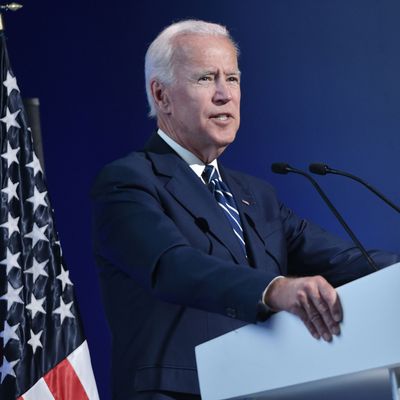
There’s no question that the story of the Democratic party right now is about the ascending left. There’s a bumper crop of self-consciously progressive candidates running for office this year, while many relatively nonideological “Establishment Democrats” are embracing policy positions and political messages long associated with party insurgents. The relative strength of various Democratic factions in Congress won’t be possible to reliably measure until after the midterms. But with the 2020 presidential election cycle soon to begin (the first candidate debates will probably be held about this time next year), it’s looking like progressives may have many more viable options for champions to send up against Donald Trump than do the centrists. That’s news in part because centrists have arguably controlled the presidential wing of the party since George McGovern’s nomination in 1972.
The obvious option for the leaderless elements of the Donkey Party is former Vice-President Joe Biden, who has near-universal name identification, a personality and biography that makes him attractive to some 2016 Trump voters, and an issues profile that won’t drive progressives off the ledge. Biden, however, is 75, with two losing presidential candidacies behind him, and doesn’t seem to have much fire in the belly at the moment. At a conference of the centrist Third Way organization in Ohio this week, there was a lot of interest in a Biden candidacy, but talk got more muted when alternatives were discussed.
Two of the three most prominent 2020 possibilities have long identified with the Democratic left, Senators Bernie Sanders and Elizabeth Warren, as have possible darkhorse candidates, Senators Sherrod Brown and Jeff Merkley. Several others, like Senators Kamala Harris, Chris Murphy and Amy Klobuchar, while not aggressively ideological, have no strong connection to the Clinton-Obama centrist tradition.
The most telling strain of Democratic presidential hopeful at present, though, involves pols once thought of as serious Clinton-style pragmatic liberals who seem to be moving in a very different direction. These include Senators Cory Booker and Kirstin Gillibrand (two loud-and-proud converts to single-payer health care) and (arguably) former Governor Martin O’Malley.
One problem for Democratic centrists has been that one typical wellspring of presidential candidacies, governors, is a bit dry at the moment. There are only 16 Democratic governors, and the only ones who have attracted any serious 2020 buzz are Colorado’s John Hickenlooper — whose overt bipartisanship probably disqualifies him from a partisan presidential run in the current environment – and Montana’s Steve Bullock, who has a long way to go in developing a clear national political presence. Yes, former Virginia Governor Terry McAuliffe is available, but his reputation for exemplifying the worst money-hustling features of the Hillary Clinton circle doesn’t make him a likely 2020 candidate. Former Massachusetts Governor Deval Patrick is a stronger possibility, in part because of his close relationship with Obama and his potential ability to add African-American votes to those of white centrists. But he’s got some corporate baggage as an associate at Bain Capital — not the best look for a Democratic presidential candidate.
For the first time in a good while, mayors are being looked at as possible presidential timber. And one recent mayor, Mitch Landrieu of New Orleans (who has also served as lieutenant governor of Louisiana), does match the Jimmy Carter/Bill Clinton template for national success, as a Southern white moderate with a particular appeal to African-Americans, thanks to the eloquent rhetoric he deployed in his fight to take down neo-Confederate symbols in his city. Another mayor, Eric Garcetti of Los Angeles, is a telegenic and business-friendly problem-solver, but could run into trouble early in the California primary in March 2020.
All these names reflect the single biggest problem for centrist Democrats if Biden doesn’t run. In a gigantic field, is their support going to be so scattered that they have no particular influence? And how many of the candidates they find most congenial will make it to, much less beyond, the starting gate?
An alternative strategy for those who most fear a Bernie Sanders nomination would be to lend support to a noncentrist candidate who represents something to the right of democratic socialism. The most obvious possibilities include those like Booker and Gillibrand who may be tacking left but who have spent some time in party circles where the current progressive wave has aroused at best mixed enthusiasm. Another option would be to give Warren another long look. She is, after all, closely associated with the “New Brandeis” movement of antitrust activists who prefer reforming capitalism to restore its competitive elements to any socialistic reliance on government in areas beyond basic public services.
The good thing about the current environment is that no one is going to suspect Democrats still pining for Bill and Hill and Barack of wanting to take a dive for the Evil One in 2020. They can make their case without damaging party unity. But they’d be smart to unite behind a strategy if not a specific candidate sooner rather than later. The presidential contest will arrive well before the spin wars over 2018 have subsided.






























